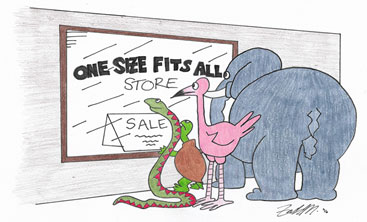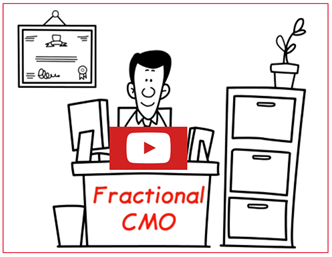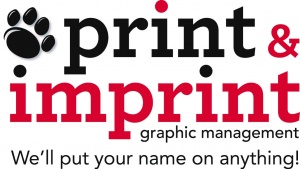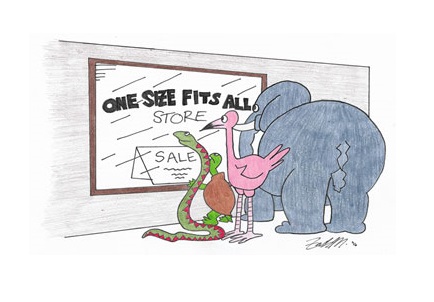One Size Fits All Marketing
In this issue:

We all know that when a garment is advertised as ‘One Size Fits All’, it never does. In fact, almost nothing offered as ‘one size fits all’, ever quite does… This is especially true when it comes to marketing efforts.
As marketers we should never assume that the same type of marketing activity, or the same version of our message, should be directed at all potential buyers.
One of Fractional CMO’s clients is a custom software development firm. Their software streamlines business processes to improve efficiency and productivity in complex environments. The individuals they work with, on the client side, vary based on the department they design the software for.
When their software is intended for use in production environments, the software developers interact with veteran engineers. Other times, they interact with younger and high-energy salespeople when they design software to improve call centers and sales processes. Clearly, the messages, benefits, language, tone, images we chose for them, and so on, had to be very different for these two very different groups of prospects.
Our marketing efforts should vary, depending on the intended recipient. Now, this does not necessarily mean (though it could) that every individual prospect (or organization) should be receiving a completely different message. It means that different groups within the target market should be receiving somewhat different messages more applicable to them. These “groups” are called “segments” in marketing. However, there is some confusion as to what market segments really are – Let’s try to clarify that.
A market segment is a subset of the target market universe from which we will be drawing customers that, relatively to your offering, is:
- Similar Within: Refers to the members of the group having some type of commonality (needs, characteristics, etc.)
- Different Without: Those in the particular segment should be different than those in other segments
- Identifiable: The fact there are some people out there with blue eyes and curly dark hair, for example, does not necessarily mean we can identify who they are (and count how many) on your mailing list, if you wanted to promote a particular hair product that’s perfect for them
- Reachable: For marketing to be effective, we should have some means to communicate our message to them
- Significant: The size of the segment should be large enough to be worth the effort and costs associated with directing specific and unique marketing efforts towards it
Understanding what constitutes a segment is very important, but it is only the first step. Performing market segmentation, i.e. dividing the target market into subsets, requires some serious work – but is well worth it!
The first step of proper market segmentation involves information gathering and analysis. You already have some information about your customers, but you might need to extract it from your records (accounting, sales, contact records, etc.). You will also need to collect more data which might be available from other sources, and in some cases, additional marketing research would be required to provide you with the information you can’t otherwise find.
Segment-specific marketing activity is one of the most powerful tools at your disposal. It allows you to tailor your message in the most meaningful way to your potential customers, and enables you to deliver it to them in a fashion that is most receptive by them.
So don’t be a ‘one size fits all’ kind of a marketer. Put in the effort to identify the segments in your target market, and then exercise creativity by customizing your marketing efforts for each.
Duke Merhavy, MBA, Ph.D.
President & Chief Marketing Officer
What Is Fractional CMO?
Hiring a full-time CMO (Chief Marketing Officer) is often not cost-effective for most small-to-mid-sized businesses (SMBs). We offer SMBs senior-level expertise, experience, and a holistic marketing approach, on a part-time basis for a fraction of the cost.
Fractional CMO is dedicated to your success, and our mission is to turn your vision into reality. Click on the short explainer video to the right for a quick explanation.
The following article is an excerpt from Tom Zender’s insightful book The Bottom Lines 2016 – 52 Unforgettable Lessons in Leadership (read more about Tom Zender below)
See the incredible shrinking business plan in three pages
Is your strategic business plan so thick that it is not read or useful? Or does it seem too daunting to even create one? The old three-inch three-ring binder plans of the past are dead. Learn how to quickly create effective 3-page living business plans.
Speed counts
The old bulky business plans took an entire staff to prepare them, filled binders and were for top management only. In fact, they were often labeled, “Secret.”
As the pace of business has accelerated, thick plans are often outdated before completed, let alone read and acted upon. Now, with transparent organizations, high-speed communications and shared information, plans are more freely communicated.
But, how do we communicate 100+ page plans? We don’t.
Make It simple and short
An effective plan of 2-3 pages begins with a short outline that covers all the essentials of a workable plan – a plan that can be easily communicated and updated. These sections are written with succinct sentences and brief bullets.
Pages 1 and 2:
Strengths – the 3-5 most important capabilities, assets, resources and successes your company has to offer its customers and other stakeholders.
Vision – in three sentences, how the company will look in 1, 2 and 3 years to the outside world and internally – what benefit the organization will provide to customers and other stakeholders.
Mission – in three sentences, what the business does, why and for whom.
Values – the top 3 essential beliefs, attitudes and behaviors by which the organization conducts itself, internally and externally.
Goals – the 5-7 highest priority goals that, when achieved, will advance the company to its next level of sustainable success.
Strategy – in 1 sentence, the overall direction of the business that guides decisions in allocating resources to best achieve the goals.
Actions – 5-7 key measurable actions by function (e.g., technology, marketing, sales, customer support, production, others) to achieve the goals – what to do, why, by when, and by whom.
Risks – the top 3 risks that could negatively impact the implementation of the plan, and how can these risks be avoided and remediated.
Page 3:
Financial – build a short and simple 1-page spreadsheet with financial assumptions and projections – such as number of customers, units sold, pricing, income statement, cash flow, balance sheet and capital needs.
Small size fits all
This simple plan has been used by small and medium size businesses. Nonprofits, which are non-taxed businesses, can benefit from a flexible 3-page plan, too. Some individuals use this format for their one-person businesses as well. If needed, any section of these plans can be separately expanded and detailed as appropriate.
Our business world rolls fast and so should you.
The bottom line
Plan ahead. Take a day or less with your team to build a 3-page strategic business plan that works. Communicate it frequently to your employees and others who can help your business. Review and update it monthly as a living guide for sustainable success.
Tom Zender is a Professional CEO Mentor. He meets amazing leaders and others along the way, and learns valuable lessons in the process. And, throughout his business career has collected hundreds of business lessons from his own experiences. These teachings are brief and simple. Yet Powerful. Mr. Zander can be reached at tomzender@me.com.
Featured Client: Print & Imprint

Susan Wallace, the owner and president of Print & Imprint, knew her company needed a total marketing refresh to remain competitive and stand out. She chose Fractional CMO to lead this effort.
After reviewing the company and the competitive landscape, Fractional CMO worked with the company’s management on a complete re-branding. That included a new name, new logo and tagline, revised positioning, and a brand new website.
Fractional CMO also started working on lead generating campaigns, as well as lead nurturing and regular client communications efforts – All part of detailed annual Marketing Plan. The uncommon superb customer service provided by Print & Imprint and the unique personality of the company are now made known to their customers and future customers.
Check out their website by clicking here or by clicking on the paw on the right.
If you’d like to learn more about how Fractional CMO helped Print & Imprint and what we might be able to do for you, give us call at 888-412-2236 or click here.
Marketing Lingo: “Value Proposition”
A value proposition is a statement containing the company’s promise to its customers of a unique and relevant benefit. The value proposition is often the core statement from which all promotional content is derived. Its purpose is to communicate to the customer a reason to buy from the company, as well as to guide the company in making decisions aligned with this promise.
A complete value proposition will identify:
- What the company does
- Who the main customers are
- What customers’ problems the company is intended to solve
- What unique benefit the company’s product delivers
- Why this benefit is better for customers than a competitor’s benefits
‘Marketing Lingo’ is a regular column in which we define, or otherwise explain, terms often used in marketing but not necessarily correctly or properly by some
Take Advantage of Us
Give us a call at 888-412-2236 or click on the button below to request a complimentary Marketing Needs Assessment, or to ask us a question regarding your most pressing marketing or sales challenges.




